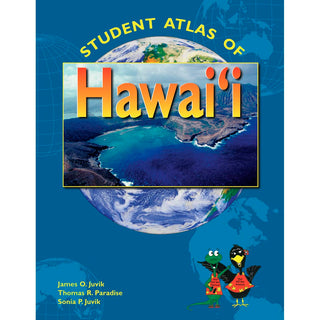No more is Hawaiʻi in the corner of the map off the California coast! Alala Crow and Moo Gecko teach young learners essential map skills while sharing information about Hawaii’s natural environment and place in the global village. From the authors of the award-winning authoritative reference book Atlas of Hawaiʻi, this colorful user-friendly atlas asks students:
- How are flat maps made from globes?
- What does map scale mean?
- How do maps show different features?
- How do maps show mountains?
- Why do geographers use maps?
- Where are we?
- Why does Hawaiʻi have different kinds of islands?
- Why are some places wet and other places dry?
- What are natural disasters?
- Where are different ecosystems found?
- Where did native plants and animals come from?
- Which plants and animals did people bring here?
- Where did the people of Hawaiʻi come from?
- Why are some land and water areas protected?
- Where do people live?
- What do farmers grow?
- Where do things we use come from?
- Why do so many tourists come to Hawaiʻi?
_____
by James Juvik, Thomas R. Paradise, Sonia Juvik
_____
paperback | 48 pages | 8.75" x 11.25" | color
REVIEWS:
“... keiki-friendly version of the lauded Hawaiʻi atlas... is colorful and full of maps, graphs, and geographic facts about Hawai‘i with many photos featuring local folks.”
—Hawaii Herald Tribune
“Lots of up-to-date data and charts... in an easy-to-digest form.”
—Honolulu Star-Bulletin
“Student Atlas of Hawaiʻi is an outstanding student atlas of Hawaiʻi which will hold particular interest for any interested in Hawaiian history and geography.”
—Children’s Bookwatch
“Were you one of the many Island students who had to suffer through the mysteries of land-dominated geography? Struggling to envision an unseen world that revolved around north America?
Student Atlas of Hawaii created by three geographers at UH-Hilo offers kamaʻaina keiki of today and tomorrow a closer look at where they come from... At last a mirror of our own reflection.”
—Honolulu Weekly
No more is Hawaiʻi in the corner of the map off the California coast! Alala Crow and Moo Gecko teach young learners essential map skills while sharing information about Hawaii’s natural environment and place in the global village. From the authors of the award-winning authoritative reference book Atlas of Hawaiʻi, this colorful user-friendly atlas asks students:
- How are flat maps made from globes?
- What does map scale mean?
- How do maps show different features?
- How do maps show mountains?
- Why do geographers use maps?
- Where are we?
- Why does Hawaiʻi have different kinds of islands?
- Why are some places wet and other places dry?
- What are natural disasters?
- Where are different ecosystems found?
- Where did native plants and animals come from?
- Which plants and animals did people bring here?
- Where did the people of Hawaiʻi come from?
- Why are some land and water areas protected?
- Where do people live?
- What do farmers grow?
- Where do things we use come from?
- Why do so many tourists come to Hawaiʻi?
_____
by James Juvik, Thomas R. Paradise, Sonia Juvik
_____
paperback | 48 pages | 8.75" x 11.25" | color
REVIEWS:
“... keiki-friendly version of the lauded Hawaiʻi atlas... is colorful and full of maps, graphs, and geographic facts about Hawai‘i with many photos featuring local folks.”
—Hawaii Herald Tribune
“Lots of up-to-date data and charts... in an easy-to-digest form.”
—Honolulu Star-Bulletin
“Student Atlas of Hawaiʻi is an outstanding student atlas of Hawaiʻi which will hold particular interest for any interested in Hawaiian history and geography.”
—Children’s Bookwatch
“Were you one of the many Island students who had to suffer through the mysteries of land-dominated geography? Struggling to envision an unseen world that revolved around north America?
Student Atlas of Hawaii created by three geographers at UH-Hilo offers kamaʻaina keiki of today and tomorrow a closer look at where they come from... At last a mirror of our own reflection.”
—Honolulu Weekly

